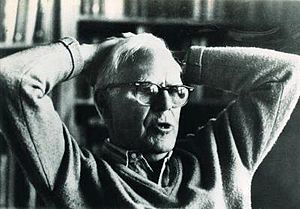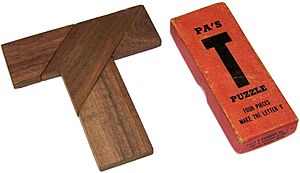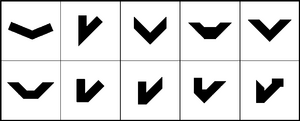T puzzle facts for kids
The T puzzle is a fun tiling puzzle. It has four special shapes. You put these shapes together to make a capital letter T. The pieces are usually one isosceles right triangle (a triangle with two equal sides and a right angle), two right trapezoids (shapes with four sides, one pair parallel, and a right angle), and one unusual five-sided shape called a pentagon.
Even though it looks simple, this puzzle can be tricky! The hardest part is often figuring out where to put the odd-shaped pentagon piece. The first T puzzles appeared around 1900. They were often given away for free to promote things. By the 1920s, wooden versions were sold in stores. Most T puzzles come with ideas for making other shapes too. The shapes you can make depend on how big each piece is compared to the others.
T-Puzzles Through Time
The T puzzle stayed popular for many years. Different versions were sold as games starting in the 1920s. For example, a French version called "L'ÉTÉ" was made by N.K. Atlas in Paris.
Another famous version was "Pa's T puzzle." This wooden puzzle was made by Drueke & Sons around the 1940s. You can see a picture of it here. Later, plastic versions also came out. "Adams T puzzle" by S.S. Adams Co was made in the 1950s. "The famous T puzzle" by Marx Toys came out in the 1960s and 1970s.
In the 1980s, there was even a "Mr T's puzzle." It featured the actor Mr. T from the TV show A-Team. The puzzle box had his famous saying: "I pity the fool who can't solve Mr. T's puzzle!"
Making More Shapes
People soon realized you could make more than just a T with the four pieces. It was like the tangram puzzle, which also uses different shapes to make pictures. In the 1930s, an advertisement for Mohawk Rugs & Carpets included a T puzzle. It challenged people to make an arrowhead shape with the pieces. In the same year, a giveaway for Eberhard Faber pencils showed 14 different shapes you could create.
Today, T puzzles are made with standard sizes. This allows you to build many extra shapes. Some important designs include:
- Nob's T puzzle: This version was designed by Nob Yoshigahara. It sold over four million copies! You can arrange its pieces to form a special five-sided shape called a symmetrical convex pentagon. This pentagon has two right angles.
- Asymmetric T: This T puzzle is not perfectly even. The left and right arms of the T are different lengths. The shorter arm is about 83% the length of the longer one. In this version, all the pieces have the same width. You can even line them up perfectly in a straight line! Today, HIQU and Eureka Toys sell this puzzle. Eureka Toys calls their version "brain twister" and it comes with 100 figures to make.
- Gardner's T: This is the puzzle that was shown in Martin Gardner's column in Scientific American magazine. The pieces of this version also form a wider, "fatter" T. This puzzle was sold as "The missing T" by Think Fun, as part of their Aha! Brain teasers classics.
Solving the T-Puzzle

With only four pieces, the T puzzle seems very easy. But it can be surprisingly hard! Studies have shown that most people cannot solve it in under five minutes. Many people need more than half an hour. Some even think the puzzle is impossible to solve!
The main problem people have is something called functional fixedness. This means they get stuck trying to place the pentagon piece only flat (horizontally) or straight up (vertically). They also tend to try and fill the little cut-out (notch) in the pentagon. One study found that people spent over 60% of their time trying these wrong ways to place the pentagon. Even when the pentagon was placed correctly, people often didn't realize it was part of the solution. It's hard to see how it fits the T shape at first.
The puzzle becomes much easier to solve once you realize something important. The pentagon piece is actually part of both the flat (horizontal) and upright (vertical) parts of the T. And the notch in the pentagon forms an inside corner of the T.
See also
 In Spanish: Rompecabezas T para niños
In Spanish: Rompecabezas T para niños





